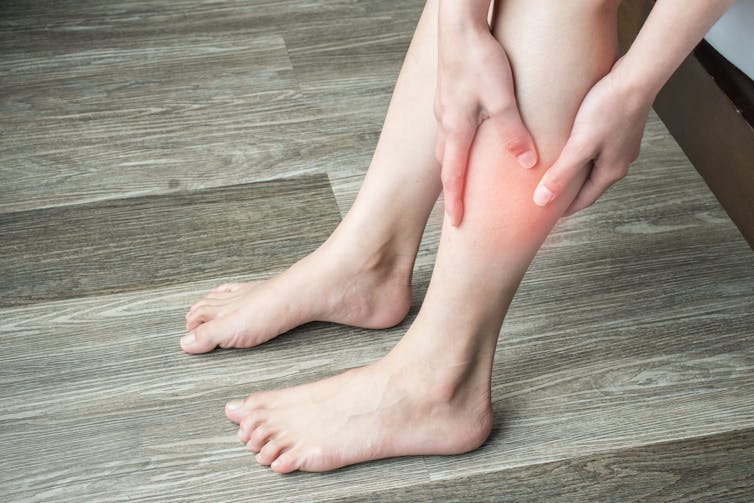Adam Taylor, Lancaster University
There’s been a lot of concern in recent days about blood clots, particularly after reports from Germany of people developing cerebral vein thrombosis – a blood clot in the brain – after receiving the Oxford/AstraZeneca vaccine. Other European countries have raised concerns about potentially increased risks of pulmonary embolisms and deep-vein thrombosis following vaccination.
However, AstraZeneca says there is currently no evidence that clots are associated with the vaccine, and the number of blood clots reported after having the vaccine is no greater than what would occur normally.
Clotting, also known as the coagulation system, is an extremely important function in the human body. Clotting helps prevent excessive blood loss both inside and outside the body when our skin, internal organs or vessels get damaged.
But though it may be a normal and essential process, if a clot becomes dislodged from where it has formed, it can become dangerous – especially if it becomes lodged in an organ, or in an artery that’s too narrow for it to fit through. This is typically known as an embolus. This can block arterial blood flow, which is essential to vital organs and may result in a pulmonary embolism (blood clot in the lungs), ischaemic stroke (clot in the brain) or a heart attack. They can also block veins, such as a deep vein thrombosis in the legs – known as a thrombus.
Many things can increase a person’s chance of developing a blood clot. Here are five:
1. Obesity
People who are obese are more than twice as likely to develop a thrombus (blood clot in the leg) compared with people of a normal weight. This is because obesity causes chronic inflammation and reduced fibrinolysis (ability to breakdown clots).
Chronic inflammation also happens as a result of having less nitric oxide in the body. Nitric oxide is a molecule that protects the specialised endothelium (the blood vessel’s lining) and prevents cells from sticking to the endothelial surface. Even at an early age, people who are obese have significantly lower levels of nitric oxide. It’s this reduced amount of nitric oxide in obese people that increases damage to the lining of blood vessels, in turn, increasing the risk of clots forming.
2. Smoking
Smoking increases the risk of blood clots forming by up to threefold.
As with obesity, smoking reduces the amount of nitric oxide in the body and encourages the blood to stick together to form clots. This process is driven in part by significantly increased levels of fibrinogen, an important component in clotting, present in the blood of smokers. Chemicals in cigarettes also cause platelets in the blood to stick together. Together, these factors make the blood thicker, making it harder for the heart to pump it around the body, in turn, damaging the inner lining of the blood vessels.
3. Flying and inactivity
Travelling long distances in aircraft, or being immobilised for a long period after major surgery, can increase the risk of blood clots in the form of deep vein thrombosis (DVT) – blood clots in the legs. The typical incidence of DVT is one in 1000, but it increases up to threefold on flights longer than three hours.

Boyloso/ Shutterstock
Because the blood is not flowing as much, the cells and proteins in blood settle out and form clumps. When the person starts moving again, these clots can move around the body and block a blood vessel if they are not broken down. Increased body mass index, age and smoking increase the risk of developing DVT from inactivity or on flights.
4. Trauma and cancer
As many as one in four people who have had major trauma, which causes damage to blood vessels – such as if large bones have been broken – develop clots. In such cases, the clot formation is linked to both the injuries to the blood vessels themselves, as well as the often prolonged bed rest associated with treatment and recovery.
Similarly, people with cancer are five to seven times more likely to develop blood clots. This is because some cancers produce increasing amounts of coagulation factors that promote clotting. Cancer also damages healthy tissues, which causes them to swell and clot.
5. Contraceptive pill
Women taking the combined oral contraceptive pill containing artificial oestrogen and progesterone have been found to have a small increased risk of blood clots. Other oral contraceptives show similar levels of increase, with about 6-17 extra events per 10,000 women treated depending on the drug used, compared with women who don’t take the oral contraceptive.
The ingredients in contraceptives increase the levels of several clotting factors circulating in the blood, which increases the odds of blood forming clots in veins.
COVID-19
Research also shows that COVID-19 patients have significantly elevated levels of a molecule that forms when clots are present. This is because COVID-19 attacks the endothelial cells lining blood vessels, causing an increase in clots throughout the body and presenting as a vascular disease. One study also found between 2 per cent and 9 per cent of COVID-19 patients develop pulmonary emboli (blood clots in the lungs). And COVID-19 patients are between three to six times more likely to develop blood clots in the veins compared with the rest of the population. Other factors – such as bed rest and age – may increase the risk of blood clots in COVID-19.
But while many factors can increase a person’s risk of blood clots, there’s still no evidence to suggest a link between the AstraZeneca vaccine and blood clots.![]()
Adam Taylor, Professor and Director of the Clinical Anatomy Learning Centre, Lancaster University
This article is republished from The Conversation under a Creative Commons licence. Read the original article.
Have you ever suffered from deep vein thrombosis? What happened to you when this happened?
If you enjoy our content, don’t keep it to yourself. Share our free eNews with your friends and encourage them to sign up.

